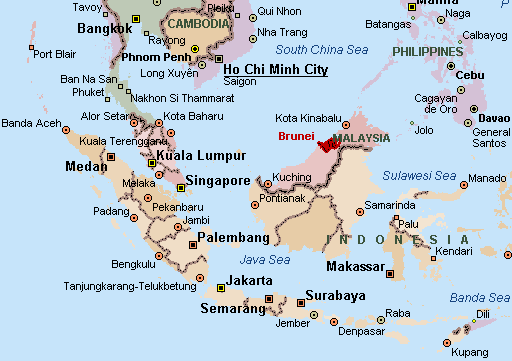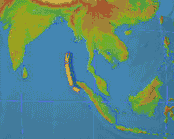Before we come to the Indian Ocean tsunami disaster we would like to pass
on a letter we received from the Brunei Chess Federation:
 Dear
Chess Friends,
Dear
Chess Friends,
The human tragedy and economic and environmental devastation brought about
by Sunday 26th December's earthquake and the ensuing Tsunamis affecting our
beloved South East Asian Nations are noted with the deepest regret. Our sympathies
go to the grieving families of the victims, and our thoughts and prayers go
to the families whose homes and livelihoods have been affected by this disaster.
Brunei Darussalam, a tiny nation in the North Eastern part of Borneo in South
East Asia, has been blessed and not been affected by the tragedy.
This email is written to reassure all prospective chess players who intended
to visit Brunei Darussalam that the Brunei Open chess tournament will proceed
as planned on the 14th Jan 2005.
Further information and registration on the Brunei Open can be obtained from
our website (below).
With Best Regards
Leong Voon Choon
Secretary General of Brunei Chess Federation
BRUNEI OPEN Chess Championship 2005
-
Confirmed players: GM Antonio Rogelio (Philippines),
GM Nelson Mariano (Philippines), GM Dao Thien Hai (Vietnam), Nguyen Anh
Dung (Vietnam), IM Nasib Ginting (Indonesia), GM Fominyh Alexander (Russia),
WGM Anya S. Corke (Hong Kong), GM Nguyen Anh Dung (Vietnam).
-
Venue: Orchid Garden Hotel, Bandar Seri Begawan, Address:
Lot 31954, Kg Anggerek Desa. BSB, BB3713 Negara Brunei Darussalam. Tel:
+6732335544 Fax: +6732335444 Email: ogh@brunet.bn
-
Official
web site (info and registration)
Brunei

In the 15-17th centuries the influence of the Sultanate of Brunei extended
over the coastal areas of northwest Borneo and the southern Philippines. In
1888, Brunei became a British protectorate; independence was achieved in 1984.
Brunei benefits from extensive petroleum and natural gas fields, the source
of one of the highest per capita GDPs in the developing world.
The Boxing Day Tsunami did not affect Brunei, which was shielded from its
effects by Thailand, Malaysia and Indonesia [BBC
flash animation here].
The Indian Ocean Tsunami
Daniel Wihlborg of Helsingborg, Sweden wrote us: "I'm wondering why ChessBase
hasn't published a single article about the terrible Tsunami disaster in the
Southeast Asian region, where 150,000 lives were wiped out. Companies (and
nations) all over the world, no matter what business they are involved in,
have donated money and expressed their grief. But you guys continue to write
chess stuff during this tragedy. This is a disaster, the worst in 100 years,
and many of your readers have relatives or friends that know people that were
there. I think you should reconsider and show some compassion despite the fact
that it's not 'Chess news'."
We do follow these activities closely, and have contacted many friends in
the devastated region. Vishy Anand, for instance, hails from Chennai (formerly
Madras) and was in fact on a holiday in his hometown at the time the Tsunami
struck the southeast coast of India. He told us that he was asleep at the time,
and that, living on higher grounds, there had been no water directly outside
his house. "I was woken by people running," he said, "but initially did not
notice anything else."

This was what the beach there looked like at the time – strong waves, but
lots of fun.
This brought back poignant memories of a holiday we spent in the seaside resort
of Mahabalipuram, south of Madras, in the early 90s. Vishy had put us up in
Fisherman's
Cove, one of the loveliest beachside resorts.
 Fisherman's
Cove took a relatively light hit – with three known casualties. Elsewhere the
devastation was apocalyptic. It was caused by an earthquake of 9.0 on the Richter
scale, the fourth largest recorded since 1900. The others
also spawned mega-tsunamis, but none were as devastating as the Indian Ocean
Tsunami of December 26, 2004.
Fisherman's
Cove took a relatively light hit – with three known casualties. Elsewhere the
devastation was apocalyptic. It was caused by an earthquake of 9.0 on the Richter
scale, the fourth largest recorded since 1900. The others
also spawned mega-tsunamis, but none were as devastating as the Indian Ocean
Tsunami of December 26, 2004.

Click to view full animation
The hypocentre was some 160 km west of Sumatra, on the extreme western end
of the "Ring of Fire", an earthquake belt that accounts for 81% of the world's
largest earthquakes. It occurred at a depth of 30 km below sea level and was
felt in Bangladesh, India, Malaysia, Myanmar, Singapore, Thailand and the Maldives.
The earthquake triggered massive tsunamis that struck the coasts of the Indian
Ocean, the deadliest tsunamis by far in all of recorded history. The total
energy of the tsunami waves was about five megatons of TNT (20 petajoules).

The main tsunami consisted of two wavefronts spaced 500 to 800 kilometres
apart. They reached a maximum height of 50 centimetres in the open ocean, only
achieving their full devastating height when entering the shallow waters of
the coast. By comparison, wind-driven waves typically reach 10 metres. However,
these waves only involve water close to the ocean surface. Tsunami waves reach
a depth of 4000 metres or more, and although they barely ripple the surface,
they speed through the water as fast as jet airliners.

A village near the coast of Sumatra after the Tsunami. U.S.
Navy photo by Photographer's Mate 2nd Class Philip A. McDaniel
The death toll from the earthquake, the tsunamis and the resultant floods
totals over 175,000 people, with tens of thousands reported missing, and over
a million left homeless. Indonesia was hit hardest, with 100,000 confirmed
deaths, followed by Sri Lanka (46,000), India (10,000) and Thailand (5000).
The only thing one can do at the moment to alleviate the suffering of the
affected people is to donate money to the relief efforts. The governments of
different nations have pledged
large sums, with the leaders being Australia ($815 million), Germany ($680m),
Japan ($500m), USA ($350m), Norway ($182m). The total sum pledged is over five
billion, although past experience has shown that not all of this will actually
be paid out.
Links


















 Dear
Chess Friends,
Dear
Chess Friends,


 Fisherman's
Cove took a relatively light hit – with three known casualties. Elsewhere the
devastation was apocalyptic. It was caused by an earthquake of 9.0 on the Richter
scale, the fourth largest recorded since 1900. The
Fisherman's
Cove took a relatively light hit – with three known casualties. Elsewhere the
devastation was apocalyptic. It was caused by an earthquake of 9.0 on the Richter
scale, the fourth largest recorded since 1900. The 







